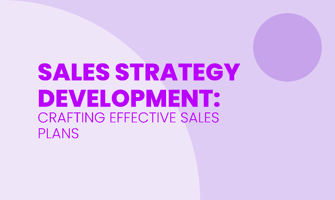Effective sales strategies are the backbone of any successful business, shaping the way products...
Adapting Sales Strategies in Changing Markets: A Guide for Sales Leaders
In sales, adapting to changing markets is crucial. Sales leaders should customize their approach to each customer, situation, and feedback. This client-focused method, called adaptive selling, helps businesses stand out in today's competitive market. Companies can improve targeting and boost sales by using big data and algorithms. So, how can sales leaders succeed in implementing adaptive selling in this changing environment? Let's explore.
Understanding the Need for Adapting Sales Strategies
Key Takeaways from Recent Market Changes
Recent market changes have shown the importance of adaptive selling. This approach means tailoring sales strategies to each buyer's unique needs and preferences.
Key aspects include customer conversion and building trust, creating personalized offers that resonate with prospects.
Understanding customers' needs helps sales organizations nurture prospects effectively, leading to increased success. Using resources like CRM software and Google Analytics for data collection is crucial for adapting sales strategies.
Implementation and improvement of adaptive selling techniques in the sales process require executive buy-in, coaching, and continuous reinforcement. Metrics and dashboards provide actionable insights to track progress and optimize strategies for successful deal closures.
Adaptive selling enables sales reps to address clients' problems, social status, and the overall situation to offer the most relevant product, leading to improved customer service and loyalty.
Components of an Adaptive Selling Strategy
Developing Communication Skills
Effective communication skills are important for adaptive selling. To develop these skills:
-
Focus on understanding buyers' needs and problems using adaptive selling techniques.
-
Tailor your approach to each buyer's unique personality and behaviors.
-
Nurture prospects effectively, improve customer conversion rates, and build customer loyalty.
-
Utilize resources like CRM software and Google Analytics for data collection.
-
Personalize offers and give relevant product recommendations based on the collected data.
Key strategies for successful adaptive selling include:
-
Collecting information about clients.
-
Adapting sales approaches to lead positions in the sales funnel.
-
Analyzing data to improve the strategy.
To implement adaptive selling:
-
Gain executive buy-in.
-
Provide manager training.
-
Integrate processes effectively.
-
Ensure sales rep adoption and continuous reinforcement.
By focusing on communication, personalization, and understanding customers' needs, you can enhance your sales process and effectively close deals.
Integrating New Technologies
New technologies can improve sales strategies by using adaptive selling techniques.
Sales reps can tailor their approach to each buyer by understanding their unique needs and preferences. This personalized approach, along with data analysis, can boost customer conversion and loyalty.
However, challenges such as executive buy-in and manager training may arise during technology implementation.
Sales organizations should focus on coaching, reinforcement, and tracking key metrics through dashboards to ensure successful integration.
Providing actionable insights and features for sales enablement can help reps adjust their communication and pitch, leading to more closed deals.
By utilizing CRM software, subscription forms, and Google Analytics, organizations can better understand their target audience and tailor offers.
This approach enhances the sales cycle, nurtures prospects, and maximizes the benefits of cross-selling and upselling.
Building Buyer Experience Focused Approaches
Companies can improve their sales strategies by personalizing communication. This involves using adaptive selling techniques to tailor solutions to customers' needs. By understanding clients' problems, social status, and the selling situation, sales organizations can increase customer conversion and loyalty. Here are some ways to do this:
-
Target the right audience.
-
Collect data using CRM software and Google Analytics for insights.
-
Utilize subscription forms and insights from sales tools for better communication.
-
Incorporate technologies like cookies to track behaviors and preferences.
-
Obtain executive buy-in and train sales teams.
-
Monitor metrics through dashboards for better outcomes.
Key Elements of Adaptive Selling
How it Works: Adaptive Selling in Action
Adaptive selling strategies involve customizing sales approaches to fit each buyer's personality and behavior. This includes adjusting communication, pitch, and the overall sales process to meet the buyer's needs.
To implement these strategies effectively, sales reps should gather data about the target audience. They should then adapt their approach based on where the buyer is in the sales process. Continuous analysis and improvement are also essential for engaging with prospects on a personalized level.
Using tools like CRM software and Google Analytics can help collect data and track customer behavior. This data can then be used to create personalized offers that appeal to the buyer. Focusing on nurturing prospects, converting leads, and building customer loyalty, as well as employing cross-selling and upselling techniques, can lead to increased customer conversion and overall success.
Providing insights, coaching, and support to the sales team can help them implement adaptive selling techniques effectively. This optimization of the sales process can result in better outcomes and growth for the organization.
Crystal: Enhancing Adaptive Communication Skills
Crystal can help improve communication skills in sales. It provides insights for adapting sales approaches to different buyers' personalities. Features like DISC categorize clients based on traits, helping sales reps adjust their style accordingly. This tool assists in responding to market changes by helping build an adaptive sales organization. It facilitates strategy transformation, executive buy-in, training, process integration, and continuous reinforcement.
Crystal offers resources like sales dashboards to monitor metrics and track success, allowing for process optimization and better outcomes in closing deals.
Executing an Adaptive Selling Strategy
Rep Adoption: Critical Steps for Success
Successful adoption of new sales strategies by representatives involves understanding and implementing adaptive selling techniques.
Managers play a key role in this process by providing coaching, resources, and reinforcement to help reps adjust their approach for different buyer personalities.
Executive buy-in is also important to align the sales organization for a smooth transition to adaptive selling.
Tracking key metrics and using sales reporting dashboards allows managers to monitor progress and success continuously.
The focus should be on personalized communication, building trust, and tailoring sales processes to meet individual buyer's needs.
This approach leads to improved customer service, higher conversion rates, and overall growth for the sales organization.
Implementing personalized selling techniques helps sales reps navigate the process, close deals, and drive success.
Manager Training: Essential for Executing New Sales Strategies
Manager training is important for implementing adaptive selling techniques in a sales team.
--By:--
-
Providing resources and coaching to managers.
-
Helping sales reps understand customer needs, behaviors, and preferences.
-
Enabling sales reps to tailor communication to each buyer.
-
Leading to higher customer conversion rates and increased trust.
--Through:--
-
Executive buy-in and continuous reinforcement.
-
Making adaptive selling a key part of the sales process.
--Resulting in:--
-
Advantages like nurturing prospects and building customer loyalty.
-
Converting more leads.
-
Tracking sales strategy effectiveness through analysis and tools.
-
Optimizing performance.
--Overall:--
-
Manager training is key for fostering personalized offers and closing more deals successfully.
Process Integration: Smoothing the Transition
Process integration helps in transitioning sales strategies smoothly.
Sales organizations can enhance their sales process and improve customer conversion by using adaptive selling techniques. These techniques focus on understanding buyers' behaviors and needs.
The approach involves personalizing communication, offering tailored solutions, and using data collection methods to create personalized offers.
To successfully integrate new technologies into sales processes, sales organizations need to:
-
Gain executive buy-in
-
Provide manager training
-
Integrate adaptive selling into existing sales methodologies
-
Ensure sales reps adopt the new techniques
-
Continuously reinforce the adaptive selling strategy
By focusing on building personalized buyer experiences and utilizing resources like CRM software, Google Analytics, and subscription forms, sales organizations can nurture prospects, convert more leads, and build customer loyalty.
Win Rates and Performance Metrics
How Adaptive Selling Improves Win Rates
Adaptive selling helps sales reps customize their approach to each client. This boosts win rates by catering to individual personalities and behaviors.
Understanding buyers' needs and preferences is key. It helps in nurturing prospects effectively, converting more leads, and building customer loyalty.
Adapting the entire sales cycle to each client is crucial. Personalized solutions should address clients' problems, social status, and the selling situation.
This personal touch leads to more relevant product offerings, higher customer conversion rates, and better trust between sales reps and buyers.
Using data collection tools like CRM software and Google Analytics is vital. They help gather insights on the target audience, adjust strategies based on client behavior, and align communication with clients' needs.
By embracing adaptive selling, sales teams can enhance communication, offer personalized solutions, and improve customer service. This drives success within the sales organization.
Metrics and dashboards play a key role in tracking the effectiveness of the sales approach. They aid in optimizing strategies, closing deals, and achieving growth in the sales process.
Achieving Executive Buy-in for Adapting Sales Strategies
Adaptive selling can help sales teams in various ways:
-
Increase customer conversion rates
-
Improve customer loyalty
-
Drive additional sales through personalized offers
To communicate these benefits effectively, sales teams should focus on showcasing how adaptive selling:
-
Nurtures prospects
-
Converts more leads into clients
-
Builds relationships by addressing unique client needs
Executives can be involved by highlighting the advantages of adaptive selling, including:
-
Improved customer service
-
Better prospect nurturing
-
Increased sales
To demonstrate ROI, tracking metrics, using sales dashboards, and providing insights on how adaptive selling techniques lead to:
-
Closing more deals
-
Understanding customer needs
-
Driving revenue growth
Continuous executive support is vital for successful implementation and long-term success of adaptive selling strategies.
Ensuring Continuous Reinforcement
Sales leaders can ensure continuous reinforcement of adaptive selling strategies within their teams. Here's how:
-
Implement measures such as executive buy-in,
-
Manager training,
-
Process integration,
-
Rep adoption,
-
Continuous reinforcement.
Champion the change to leadership teams, educate managers, integrate adaptive selling into sales methodologies, prioritize rep adoption, and monitor key metrics.
Utilize resources like CRM software, Google Analytics, and subscription forms to collect data. This helps maintain focus on adaptive selling, personalize offers, understand customer behaviors, and communicate effectively.
This leads to successful customer conversion and growth in sales organizations.
FAQ
How can sales leaders identify changing market trends?
Sales leaders can identify changing market trends by closely monitoring industry publications, attending conferences and networking events, and staying in touch with customers and competitors. They can also utilize online tools such as Google Trends and social media analytics.
What factors should sales leaders consider when adapting sales strategies?
Sales leaders should consider factors such as industry trends, customer needs, competitor actions, and sales team skills when adapting sales strategies. For example, leveraging new technologies for more efficient prospecting or adjusting messaging based on market changes.
How can sales leaders optimize their team's performance in a changing market?
Sales leaders can optimize their team's performance in a changing market by providing ongoing training and development, implementing data-driven strategies, and staying adaptable to new trends.
For example, they can offer regular workshops on new sales techniques, utilize customer data analytics to target potential leads, and encourage team members to stay informed about industry shifts.
What role does customer feedback play in adjusting sales strategies?
Customer feedback helps to identify areas for improvement in sales strategies, such as pricing, product features, and customer service. For example, if feedback reveals a common complaint about high prices, adjusting pricing strategies can attract more customers and increase sales.
How important is it for sales leaders to stay informed about industry changes?
It is extremely important for sales leaders to stay informed about industry changes in order to adapt strategies, stay ahead of competitors, and meet customer demands. For example, staying updated on emerging technologies can help sales teams incorporate new tools for better efficiency and productivity.





